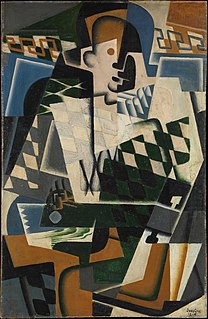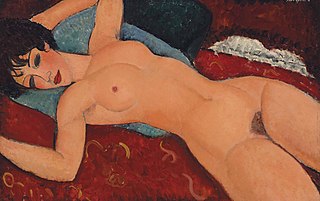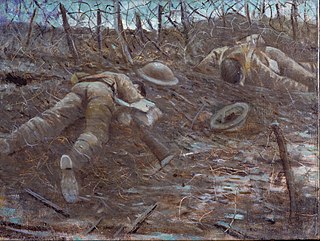 W
WAb ovo is a 1917 painting by Paul Klee (1879–1940) made during his time in the German Army, which is particularly noteworthy for its sophisticated technique. It employs watercolor on gauze and paper with a chalk ground, which produces a rich texture of triangular, circular, and crescent patterns.
 W
WFront Elevation for a Monument to the Unknown Soldier is a painting by Antonio Sciortino, from 1917.
 W
WHarlequin with a Guitar is an early 20th century painting by Spanish cubist Juan Gris. Done in oil on panel, the work is in the collection of the Metropolitan Museum of Art.
 W
WThe Jack Pine is a well-known oil painting by Canadian artist Tom Thomson. A representation of the most broadly distributed pine species in Canada, it is considered an iconic image of the country's landscape, and is one of the country's most widely recognized and reproduced artworks.
 W
WThe Last Supper is a painting depicting the Lord's Supper created by Lazzaro Pisani. It is currently the titular altarpiece of the Parish Church in Għasri dedicated to the Institution of the Eucharist.
 W
WNu couché is a 1917 oil on canvas painting by the Italian artist Amedeo Modigliani. It is one of his most widely reproduced and exhibited paintings.
 W
WNu couché is a 1917 painting by Amedeo Modigliani. The painting was included in a 2017/2018 Tate Modern exhibition of Modigliani's works. The painting was sold by auction by Sotheby's in April 2018. Writing in The Guardian, British arts journalist Jonathan Jones compared it to Ingres' 1814 work Grande Odalisque.
 W
WNude Sitting on a Divan is an oil on canvas painting by Italian artist Amedeo Modigliani depicting a partially draped woman seated with crossed legs against a warm red background. The work was one of a series of nudes painted by Modigliani in 1917 that created a sensation when exhibited in Paris that year. On November 2, 2010, the painting sold at a New York auction for $68.9 million, a record price for an artwork by Modigliani.
 W
WThe Painter and His Model is a work by Henri Matisse painted late 1916, early 1917. It is currently in the collection of the Musée National d'Art Moderne, Centre Georges Pompidou, Paris. In this work Matisse depicted himself in his studio on the fourth floor of 19 Quai Saint-Michel, at work on his painting Laurette in a Green Robe (1916).
 W
WPaths of Glory is a 1917 painting by British artist Christopher Nevinson. The title quotes from a line from Thomas Gray's 1750 poem Elegy Written in a Country Churchyard: "The paths of glory lead but to the grave". It is held by the Imperial War Museum in London, which describes it as "one of Nevinson's most famous paintings".
 W
WPortrait of Blaise Cendrars is a 1917 oil on card painting by Amedeo Modigliani, showing the French writer Blaise Cendrars. Formerly part of the Riccardo Gualino collection, it is now in the Galleria Sabauda in Turin.
 W
WPortrait of Vincent Nubiola is an oil painting by Spanish artist Joan Miró. Painted in 1917 when Miró was 24 years old, a year before his first exhibition, the portrait is now considered a masterpiece from a period when he experimented with both Cubism and Fauvism. It is also said by some art critics to show the influence of Van Gogh. Acquired for a time by Picasso, the painting is now in the permanent collection of the Folkwang Museum in Essen (Germany).
 W
WReclining Nude is a painting by Italian artist Amedeo Modigliani. Done in oil on canvas in 1917, the painting was one of Modigliani's celebrated series of nudes. The work is in the collection of the Metropolitan Museum of Art.
 W
WRefugees is a painting by Latvian artist Jēkabs Kazaks from 1917.
 W
WSeated Nude is a 1917 painting by Amedeo Modigliani, now in the Royal Museum of Fine Arts, Antwerp.
 W
WSelf-portrait is one of the earliest works of Croatian artist Marino Tartaglia. He painted it in 1917, in the expressionist style.
 W
WThe Philosophers is an oil on canvas painting executed in 1917 by the Russian artist Mikhail Nesterov which is in the collection of the Tretyakov Gallery, Moscow.
 W
WTulip Hysteria Co-ordinating is a fictitious work of art by Marcel Duchamp.
 W
WThe West Wind is a 1917 painting by Canadian artist Tom Thomson. An iconic image, the pine at its centre has been described as growing "in the national ethos as our one and only tree in a country of trees". It was painted in the last year of Thomson's life and was one of his final works on canvas.
 W
W W
W W
W W
W W
W W
W W
W W
W